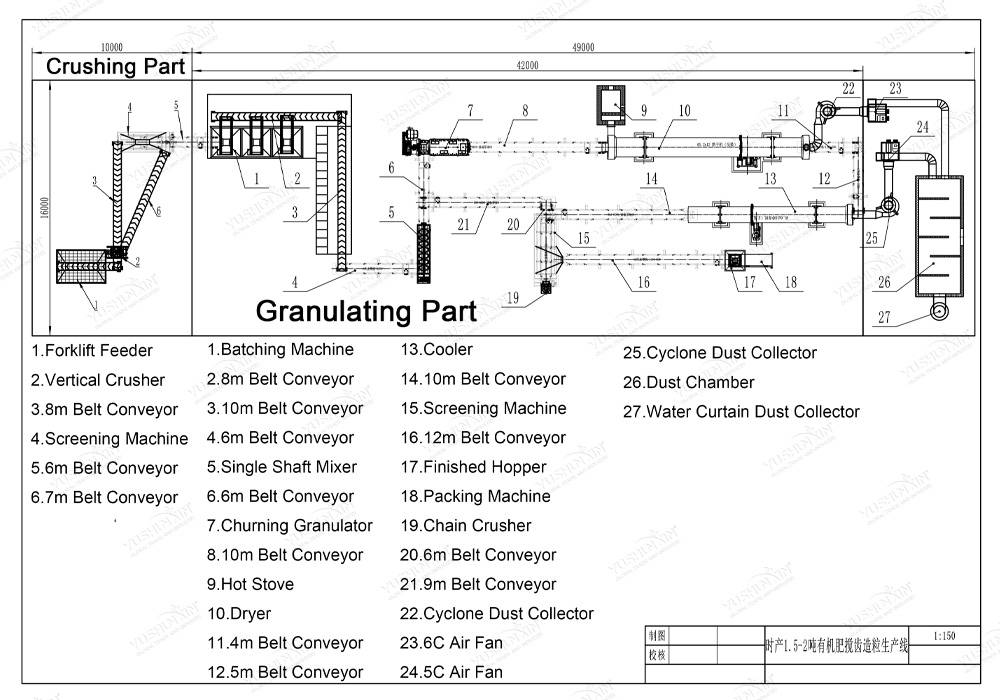

Raw Material Storage and Feeding Systems:
Mezcla de equipos:
Equipo de granulación (If required):
Drying Equipment:
Cooling Equipment:
Sieving and Screening Equipment:
Coating Equipment (Opcional):
Equipo de embalaje:

Primary Nutrients:
Nutrientes secundarios:
Micronutrientes (Elementos traza):
Agentes quelantes (for micronutrients):
Acidulants or pH Adjusters:
Aditivos:
Carrier Materials (opcional):
El costo de cada línea de producción varía según la capacidad de producción., grado de automatización, y necesidades específicas. Complete el siguiente formulario y le proporcionaremos una cotización precisa!
Si está interesado en nuestro equipo de fabricación de fertilizantes, Envíe sus requisitos y contactos y luego nos comunicaremos con usted en dos días. Prometemos que toda su información no se filtrará a nadie.
- La compañía fue fundada en 2005 y se ha centrado en la investigación y el desarrollo y la fabricación de equipos de fertilizantes orgánicos para 20 años. Ha construido una base de producción de equipos de fertilizantes orgánicos a gran escala de 40,000 m, Uso de granulación avanzada, Tecnologías de secado y detección para mejorar la eficiencia de producción y la calidad del producto.
- Una empresa de importación y exportación autoperada con más de 80 ingenieros profesionales en todo el mundo, sirviendo más de 100 países y regiones de todo el mundo, 5,000+ casos de servicio al cliente, 10 centros de procesamiento, 3 máquinas de corte con láser, y más de 60 equipo de varios tipos.
- Mantenimiento de la cooperación a largo plazo y extensa con muchos institutos y universidades de investigación científica, with a professional R&D team, Puede optimizar continuamente el rendimiento del equipo de acuerdo con la demanda del mercado.
- Materiales resistentes al desgaste de alta resistencia, El acero al carbono Q235/aleación se seleccionan para garantizar que el equipo sea duradero y reduzca los costos de mantenimiento.
- Adoptar sistemas de control inteligentes para mejorar el nivel de automatización de la producción y reducir la dependencia manual.
- ISO, Ceñudo, Certificación SGS International
- Con capacidad de producción a gran escala, puede cumplir con diferentes requisitos de capacidad de producción (pequeño, líneas de producción medianas y grandes).
- Una gama completa de modelos de equipos, Adecuado para la producción de varios tipos de fertilizantes como el fertilizante orgánico, fertilizante compuesto, fertilizante biológico, fertilizante soluble en agua, fertilizante líquido, etc..
- Se puede proporcionar un diseño personalizado de acuerdo con las necesidades del cliente, incluida la capacidad de producción, diseño del sitio, Estándares de protección del medio ambiente, etc..
- Proporcionar un conjunto completo de soluciones de línea de producción, incluyendo selección de equipos, instalación y puesta en marcha, capacitación técnica, etc..

- Suministro de fábrica directa, Reducir el enlace intermediario, y el precio es más competitivo.
- El equipo tiene alta eficiencia energética, reduce el consumo de energía, y ayuda a los clientes a reducir los costos operativos a largo plazo.
- Suministro de fábrica directa, Reducir el enlace intermediario, y el precio es más competitivo.
- El equipo tiene alta eficiencia energética, reduce el consumo de energía, y ayuda a los clientes a reducir los costos operativos a largo plazo.
Entrega exitosa de granuladores de doble rodillo de 1 T/H a clientes en Turquía y el Reino Unido
Solución eficiente de volteo de abono entregada a un cliente filipino
Entrega exitosa de granulador de discos a cliente chileno para producción de fertilizantes
Impulsar la eficiencia de peletización para GoodEarth Group, Sudáfrica
Los clientes ecuatorianos elogian mucho la máquina de desagüe de aguas residuales
Elogios del cliente de Vietnam por la línea de producción de fertilizantes de potasio
La línea de fertilizantes mexicanos se instaló correctamente
Nuestro equipo de producción de fertilizantes se ha entregado con éxito a Australia sin ningún daño.
Cargando nuestra línea de producción de fertilizantes orgánicos